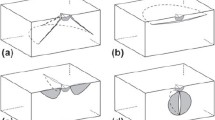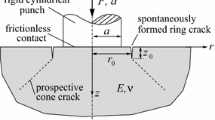Abstract
Extension of the indentation fracture toughness estimation method to very small length scales often requires the use of an indenting punch much more acute than the oft-used Vickers probe. Experimental results for very acute, sharp probes have motivated a new approach to the indentation fracture mechanics of radial crack development. An extension of the standard two-component (residual elastic–plastic+elastic contact) stress-field model of radial fracture is proposed, based on the concept that a sufficiently acute indenter can also act as a ‘wedge,’ prying open the surface-located radial cracks. In this, the first of a two-part series, a three-component wedging indentation model is constructed, and some general characteristics of the model are explored. In particular, the implications of the three-component stress field of the model for the description of radial crack development during load-unload indentation cycles of acute probes are considered. Explicit predictions of crack development are compared with the qualitative features of experimental observations, providing a basis for the quantitative comparisons in Part II.
Similar content being viewed by others
References
Akiyama, T., Hara, T., Shibuya, T. and Koizumi, T. (1995). Axisymmetric contact problem of an elastic half-space involving tangential displacement. In: Theoretical and Applied Mechanics. University of Tokyo Press, Tokyo, 44, pp. 41–49
G.R. Anstis P. Chantikul B.R. Lawn D.B. Marshall (1981) ArticleTitleA critical evaluation of indentation techniques for measuring fracture toughness. I. Direct crack measurements Journal of the American Ceramic Society 64 533–538
A. Arora D.B. Marshall B.R. Lawn M.V. Swain (1979) ArticleTitleIndentation deformation/fracture of normal and anomalous glasses Journal of Non-Crystalline Solids 31 415–428 Occurrence Handle10.1016/0022-3093(79)90154-6
S.S. Chiang D.B. Marshall A.G. Evans (1982) ArticleTitleThe response of solids to elastic/plastic indentation I. Stresses and residual stresses Journal of Applied Physics 53 298–311 Occurrence Handle1982JAP....53..298C
R.F. Cook (1985) Strength Characterisation of Ceramics Using Controlled Indentation Flaws University of New South Wales Sydney
R.F. Cook G.M. Pharr (1990) ArticleTitleDirect observation and analysis of indentation cracking in glasses and ceramics Journal of the American Ceramic Society 73 787–817
R.D. Dukino M.V. Swain (1992) ArticleTitleComparative measurement of indentation fracture toughness with Berkovich and Vickers indenters Journal of the American Ceramic Society 75 3299–3304 Occurrence Handle10.1111/j.1151-2916.1992.tb04425.x
V.I. Fabrikant (1990) ArticleTitleAxisymmetric bonded punch problem: a complete solution Ingenieur-Archiv 60 213–224 Occurrence Handle10.1007/BF00577858 Occurrence Handle0713.73081
Hay, J.C., Bolshakov, A. and Pharr, G.M. (1998). Applicability of Sneddon relationships to the real case of a rigid cone penetrating an infinite half space. In: Materials Research Society Symposium Proceedings Vol. 522 pp. 263–268.
J.C. Hay A. Bolshakov G.M. Pharr (1999) ArticleTitleA critical examination of the fundamental relations used in the analysis of nanoindentation data Journal of Materials Research 14 2296–2305 Occurrence Handle1999JMatR..14.2296H
J.C. Hay G.M. Pharr (1998) ArticleTitleExperimental investigations of the Sneddon solution and an improved solution for the analysis of nanoindentation data In: Materials Research Society Symposium Proceedings 522 39–44
K.L. Johnson (1999) Contact Mechanics Cambridge University Press Cambridge
K. Kese D.J. Rowcliffe (2003) ArticleTitleNanoindentation method for measuring residual stress in brittle materials Journal of the American Ceramic Society 86 811–816
M.T. Laugier (1985) ArticleTitlePalmqvist crack extension and the center-loaded penny crack analogy Journal of the American Ceramic Society 68 C51–C52
B.R. Lawn (1993) Fracture of Brittle Solids Cambridge University Press Cambridge
B.R. Lawn A.G. Evans (1977) ArticleTitleA model of crack initiation in elastic/plastic indentation fields Journal of Materials Science 12 2195–2199
B.R. Lawn A.G. Evans D.B. Marshall (1980) ArticleTitleElastic/plastic indentation damage in ceramics: The median/radial crack system Journal of the American Ceramic Society 63 574–581
X.D. Li B. Bhushan (2001) ArticleTitleMicro/nanomechanical and tribological studies of bulk and thin-film materials used in magnetic recording heads Thin Solid Films 398 313–319 Occurrence Handle10.1016/S0040-6090(01)01343-8
Y.Y. Lim M.M. Chaudhri (1999) ArticleTitleAccurate determination of the mechanical properties of thin aluminum films deposited on sapphire flats using nanoindentations Journal of Materials Research 14 2314–2327 Occurrence Handle1999JMatR..14.2314L
D.B. Marshall B.R. Lawn (1979) ArticleTitleResidual stress effects in sharp contact cracking, part I, indentation fracture mechanics Journal of Materials Science 14 2001–12
D.J. Morris R.F. Cook (2004) ArticleTitleIn situ cube-corner indentation of soda-lime glass and fused silica Journal of the American Ceramic Society 87 1494–1501
D.J. Morris S.B. Myers R.F. Cook (2004) ArticleTitleSharp probes of varying acuity: instrumented indentation and fracture behavior Journal of Materials Research 19 165–175 Occurrence Handle10.1557/jmr.2004.19.1.165
W.C. Oliver G.M. Pharr (1992) ArticleTitleAn improved technique for determining hardness and elastic modulus using load and displacement sensing indentation experiments Journal of Materials Research 7 1564–1583 Occurrence Handle1992JMatR...7.1564O
W.C. Oliver G.M. Pharr (2004) ArticleTitleMeasurement of hardness and elastic modulus by instrumented indentation: Advances in understanding and refinements to methodology Journal of Materials Research 19 3–20 Occurrence Handle10.1557/jmr.2004.19.1.3
G.M. Pharr (1998) ArticleTitleMeasurement of mechanical properties by ultra-low load indentation Materials Science & Engineering A A253 151–159
G.M. Pharr A. Bolshakov (2002) ArticleTitleUnderstanding nanoindentation unloading curves Journal of Materials Research 17 2660–2671
Pharr, G.M., Harding, D.S. and Oliver W.C. (1993). Measurement of fracture toughness in thin films and small volumes using nanoindentation methods. In NATO ASI – Mechanical Properties and Deformation Behavior of Materials Having Ultra-Fine Microstructures (edited by) Nastasi, M. Parkin, D.M. and Gleiter, H., NATO ASI, Boston, pp. 449–461.
G.M. Pharr W.C. Oliver F.R. Brotzen (1992) ArticleTitleOn the generality of the relationship among contact stiffness, contact area, and elastic modulus during indentation Journal of Materials Research 7 613–617 Occurrence Handle1992JMatR...7..613P
I.N. Sneddon (1965) ArticleTitleThe relation between load and penetration in the axisymmetric Boussinesq problem for a punch of arbitrary profile International Journal of Engineering Science 3 47–57 Occurrence Handle10.1016/0020-7225(65)90019-4 Occurrence Handle0128.42002 Occurrence Handle32 #651
T.A. Venkatesh K.J. Vliet ParticleVan A.E. Giannakopoulos S. Suresh (2000) ArticleTitleDetermination of elasto-plastic properties by instrumented sharp indentation: guidelines for property extraction Scripta Materialia 42 833–839 Occurrence Handle10.1016/S1359-6462(00)00311-0
B. Wolf P. Paufler (1999) ArticleTitleMechanical properties of icosahedral AlPdMn probed by indentation at variable temperatures Physica Status Solidi A 172 341–361 Occurrence Handle1999PSSAR.172..341W
E.H. Yoffe (1982) ArticleTitleElastic stress field caused by indenting brittle materials Philosophical Magazine A 46 617–628
Author information
Authors and Affiliations
Corresponding author
Rights and permissions
About this article
Cite this article
Morris, D.J., Cook, R.F. Radial Fracture During Indentation by Acute Probes: I, Description by an Indentation Wedging Model. Int J Fract 136, 237–264 (2005). https://doi.org/10.1007/s10704-005-6034-9
Received:
Accepted:
Issue Date:
DOI: https://doi.org/10.1007/s10704-005-6034-9




